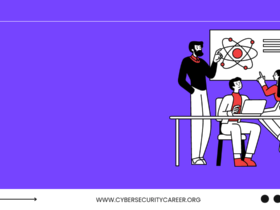Most entry-level and mid-level cybersecurity jobs, such as cybersecurity analysts, don’t require a lot of arithmetic skills. There are numerous graphs and data analyses, although the level of arithmetic required isn’t extremely high. You can succeed if you can manage simple programming and problem-solving. You’ll need the following to get there.
Does math play a role in cybersecurity?
Yes, it is a quick response.
Computer science’s technical subject of cybersecurity necessitates strong analytical abilities from job candidates. Unlike astrophysics or engineering, it is not a math-intensive job, although it does require familiarity with some forms of math. Beyond entry-level positions, cybersecurity analysts and professionals must become accustomed to the idea of employing basic mathematics.
Consider it in this way. Probability and risk are examples of natural events that are expressed mathematically. It is crucial to communicate effectively with information systems. You will be better able to interpret complex real-world problems into something that a computer can comprehend and understand once you have learned the “language” of math.
You probably already apply this kind of math daily without even realising it. For instance, when estimating risk, you can ask yourself, “What is the likelihood that I’ll face a worst-case scenario?” and then factor in all of your prior experiences and your understanding of the circumstance. To depict the risk threat in cybersecurity, you would transform this mental process into a certain equation.
The foundation of computer data is binary math. Since binary is how computer operations are computed and, in a more practical sense, how we determine important things like IP addresses and networks, a lot of the math you’ll be expected to know in entry-level cyber security or support professions will pertain to binary math.
And what exactly is binary math?
Binary math is the transformation of any data set into a collection of ones and zeros. Computers can only process this binary data, so we have to convert it. You’ve probably seen something similar before, where a computer can decipher a string of ones and zeros, like 100011011001010, and interpret it as another value, like a number, word, or image. Every bit of information on the internet or a computer, including tablets and mobile phones, is fundamentally just a collection of binary.
To deal with this binary math, you must be familiar with some fundamental algebra based on the power of two, which gives us numbers like 2, 4, 8, 16, and so on. You’ll start to comprehend things like how, for example, the number 12 is written in binary as 1100 if you have a basic understanding of how a binary operates. Let’s look more closely:
We may anticipate that in a simple binary string of four digits, the first digit will have the value of 8, followed by the value of 4, then 2 and then 1, like in this pattern: 8,4,2,1. The bit is on or ready to be counted when a binary number is set to one. Consequently, a binary string of 1,1,0,0 turns on or adds the numbers 8, 4, and 12, for a total of 12. When writing the binary, we omit the commas from the example and get at 1100, which denotes a value of 12.
What Percentage of Cyber Security Is Math-Based?
Before you can move to management or run your own cybersecurity company, you’ll likely need to learn some arithmetic if you want to work in cybersecurity. Nevertheless, because there are sub-disciplines, it’s possible that, depending on your chosen subject, you won’t deal with its advanced forms.
Consider the distinction between a cybersecurity expert who works on cryptographic techniques and a cybersecurity professional who offers security services for a local area network (LAN). While the latter must understand complex mathematical concepts linked to the field, the former does not require much arithmetic.
Most contemporary encryption techniques rely on intricate mathematical concepts like enormous primes. This suggests that if you pursue a career in encryption technology, you will have to deal with challenging mathematical concepts that necessitate a solid understanding if you hope to succeed.
As a result, cybersecurity today significantly relies on complex mathematics to solve problems, especially with emerging technologies like machine learning and analytics. The efficient accomplishment of your tasks is made possible by using mathematical concepts in the domain.
Which kind of mathematics is required for cyber security?
The varied forms of arithmetic you will encounter in the various sectors of the industry show how diverse the profession is. A fundamental high school understanding of mathematics may be necessary for jobs like binary and programming. This alters, though, as advanced cybersecurity programmes emphasise higher-level math ideas like calculus.
Because both entail coming up with innovative solutions to problems, some areas of cybersecurity, such as network security, correlate with the skills required in math. Math is useful in cybersecurity because it encourages creativity and multiple ways to solve intriguing problems instead of simply utilising a tool to attack.
Cryptography and Math
Cryptography is a major component of cyber security and protecting our data, which is the science of codes and encryption. Depending on what it is used for, cryptography’s arithmetic can be anything from very simple to quite complex. The degree and complexity of the math you’ll have to work with will depend on how far you decide to go in your profession, just like in the math examples above. Simple cryptography can resemble something like this:
A = A
B = B
C = C
Then, we can use a rotation-based cryptography concept, such as ROT. Use ROT2, which indicates that everything rotates or shifts by 2, to achieve the following:
A = C
B = D
C = E
In this case, it would be necessary for someone to know that you are employing a rotation of two to decrypt the data. Even while math can be quite precise, it is often not as difficult as other disciplines like computer programming or engineering.
Do certification examinations include math?
Only the fundamental math ideas this article covers are typically required for entry-level cyber security certification exams. You must be familiar with hexadecimal and binary and how they function in a secure network environment if you choose to pursue any of the foundational CompTIA certifications, including A+, Network+, and Security+. The same applies to other certificates, such as the Microsoft Certified Professional (MCP), the Cisco CCENT or CCNA.
Where Can I Find Math Classes for Cybersecurity?
A cybersecurity degree is a trusted and proven approach to entering the business with a solid foundation. With a computer science or cybersecurity degree, you can easily find employment in the public and commercial sectors and develop the skills you need to move between sectors.
However, there are other ways to understand cybersecurity topics. Some cybersecurity professionals are self-taught, having picked up their craft through pursuits like white-hat hacking and online training on platforms like Udemy. Getting involved, though, is more difficult on this route. A more reliable route to becoming an organization or enterprise’s cybersecurity specialist is to obtain a degree in this discipline.
The mathematical concepts necessary to work in this profitable industry are taught in cybersecurity degrees. Other universities offer programs in the area with different titles but the same course materials. Since cybersecurity is a subset of computer science, and the former covers it as well as other concepts, getting a degree in the subject is another good method to break into the industry.
Another way to obtain qualifications and practise skills for cybersecurity is to work for tech behemoths like Google, IBM, and Huawei. They provide quick courses, usually online, and exams to gauge your proficiency. You can acquire industry-respected badges and certificates in the relevant fields by passing them.
Conclusion
Your advancement in cybersecurity is certain with some experience, a few certificates, and a degree in cybersecurity or computer science; the difficult math concepts are only a necessary component of it. The ideas serve as a foundation for problem analysis and the creation of solutions.
You won’t be walking around doing logarithm calculations or graphing but rather evaluating systems, putting up defenses against vulnerabilities you find, and updating them to deal with new threats. Otherwise, as a cybersecurity enthusiast, you have worse math nightmares than a specialist in an area like analytics and big data.










Leave a Reply